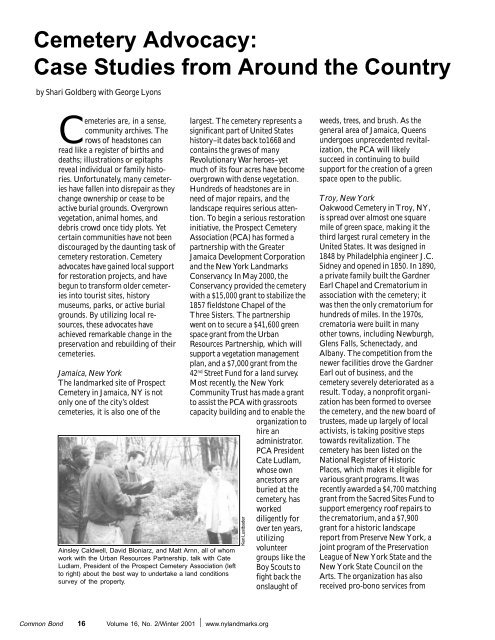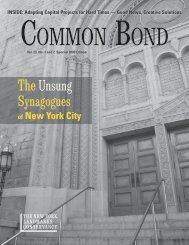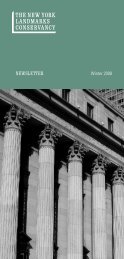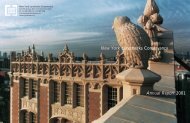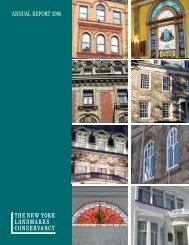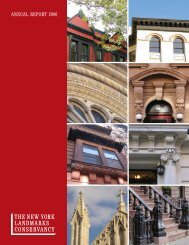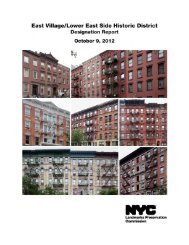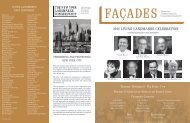Download Common Bond - The New York Landmarks Conservancy
Download Common Bond - The New York Landmarks Conservancy
Download Common Bond - The New York Landmarks Conservancy
Create successful ePaper yourself
Turn your PDF publications into a flip-book with our unique Google optimized e-Paper software.
Cemetery Advocacy:<br />
Case Studies from Around the Country<br />
by Shari Goldberg with George Lyons<br />
Cemeteries are, in a sense,<br />
community archives. <strong>The</strong><br />
rows of headstones can<br />
read like a register of births and<br />
deaths; illustrations or epitaphs<br />
reveal individual or family histories.<br />
Unfortunately, many cemeteries<br />
have fallen into disrepair as they<br />
change ownership or cease to be<br />
active burial grounds. Overgrown<br />
vegetation, animal homes, and<br />
debris crowd once tidy plots. Yet<br />
certain communities have not been<br />
discouraged by the daunting task of<br />
cemetery restoration. Cemetery<br />
advocates have gained local support<br />
for restoration projects, and have<br />
begun to transform older cemeteries<br />
into tourist sites, history<br />
museums, parks, or active burial<br />
grounds. By utilizing local resources,<br />
these advocates have<br />
achieved remarkable change in the<br />
preservation and rebuilding of their<br />
cemeteries.<br />
Jamaica, <strong>New</strong> <strong>York</strong><br />
<strong>The</strong> landmarked site of Prospect<br />
Cemetery in Jamaica, NY is not<br />
only one of the city’s oldest<br />
cemeteries, it is also one of the<br />
Ainsley Caldwell, David Bloniarz, and Matt Arnn, all of whom<br />
work with the Urban Resources Partnership, talk with Cate<br />
Ludlam, President of the Prospect Cemetery Association (left<br />
to right) about the best way to undertake a land conditions<br />
survey of the property.<br />
largest. <strong>The</strong> cemetery represents a<br />
significant part of United States<br />
history–it dates back to1668 and<br />
contains the graves of many<br />
Revolutionary War heroes–yet<br />
much of its four acres have become<br />
overgrown with dense vegetation.<br />
Hundreds of headstones are in<br />
need of major repairs, and the<br />
landscape requires serious attention.<br />
To begin a serious restoration<br />
initiative, the Prospect Cemetery<br />
Association (PCA) has formed a<br />
partnership with the Greater<br />
Jamaica Development Corporation<br />
and the <strong>New</strong> <strong>York</strong> <strong>Landmarks</strong><br />
<strong>Conservancy</strong>. In May 2000, the<br />
<strong>Conservancy</strong> provided the cemetery<br />
with a $15,000 grant to stabilize the<br />
1857 fieldstone Chapel of the<br />
Three Sisters. <strong>The</strong> partnership<br />
went on to secure a $41,600 green<br />
space grant from the Urban<br />
Resources Partnership, which will<br />
support a vegetation management<br />
plan, and a $7,000 grant from the<br />
42 nd Street Fund for a land survey.<br />
Most recently, the <strong>New</strong> <strong>York</strong><br />
Community Trust has made a grant<br />
to assist the PCA with grassroots<br />
capacity building and to enable the<br />
organization to<br />
hire an<br />
administrator.<br />
PCA President<br />
Cate Ludlam,<br />
whose own<br />
ancestors are<br />
buried at the<br />
cemetery, has<br />
worked<br />
diligently for<br />
over ten years,<br />
<strong>Common</strong> <strong>Bond</strong> 16 Volume 16, No. 2/Winter 2001 ⏐ www.nylandmarks.org<br />
Ken Lustbader<br />
utilizing<br />
volunteer<br />
groups like the<br />
Boy Scouts to<br />
fight back the<br />
onslaught of<br />
weeds, trees, and brush. As the<br />
general area of Jamaica, Queens<br />
undergoes unprecedented revitalization,<br />
the PCA will likely<br />
succeed in continuing to build<br />
support for the creation of a green<br />
space open to the public.<br />
Troy, <strong>New</strong> <strong>York</strong><br />
Oakwood Cemetery in Troy, NY,<br />
is spread over almost one square<br />
mile of green space, making it the<br />
third largest rural cemetery in the<br />
United States. It was designed in<br />
1848 by Philadelphia engineer J.C.<br />
Sidney and opened in 1850. In 1890,<br />
a private family built the Gardner<br />
Earl Chapel and Crematorium in<br />
association with the cemetery; it<br />
was then the only crematorium for<br />
hundreds of miles. In the 1970s,<br />
crematoria were built in many<br />
other towns, including <strong>New</strong>burgh,<br />
Glens Falls, Schenectady, and<br />
Albany. <strong>The</strong> competition from the<br />
newer facilities drove the Gardner<br />
Earl out of business, and the<br />
cemetery severely deteriorated as a<br />
result. Today, a nonprofit organization<br />
has been formed to oversee<br />
the cemetery, and the new board of<br />
trustees, made up largely of local<br />
activists, is taking positive steps<br />
towards revitalization. <strong>The</strong><br />
cemetery has been listed on the<br />
National Register of Historic<br />
Places, which makes it eligible for<br />
various grant programs. It was<br />
recently awarded a $4,700 matching<br />
grant from the Sacred Sites Fund to<br />
support emergency roof repairs to<br />
the crematorium, and a $7,900<br />
grant for a historic landscape<br />
report from Preserve <strong>New</strong> <strong>York</strong>, a<br />
joint program of the Preservation<br />
League of <strong>New</strong> <strong>York</strong> State and the<br />
<strong>New</strong> <strong>York</strong> State Council on the<br />
Arts. <strong>The</strong> organization has also<br />
received pro-bono services from


